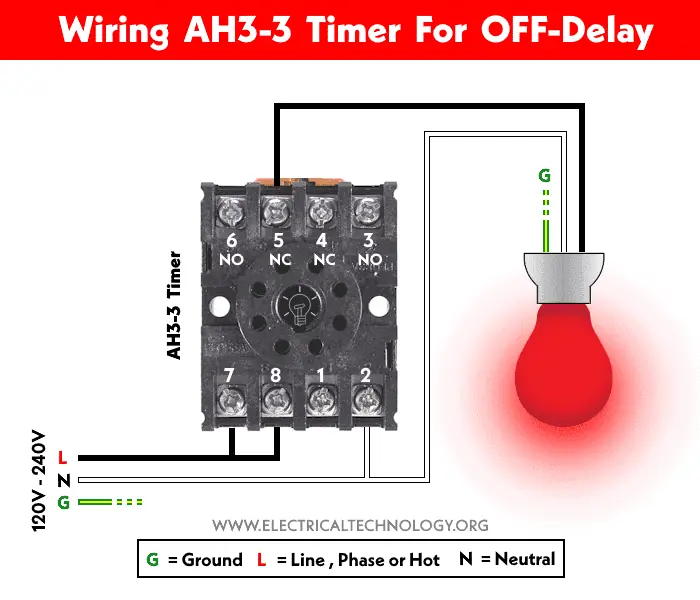Pendahuluan
Pengatur waktu tunda aktif dan tunda nonaktif adalah komponen penting dalam sistem kontrol, masing-masing memiliki fungsi yang berbeda berdasarkan perilaku pengaturan waktu dalam kaitannya dengan sinyal input. Sementara pengatur waktu tunda aktif memperkenalkan penundaan sebelum mengaktifkan output, pengatur waktu tunda tidak aktif mempertahankan output untuk durasi yang ditetapkan setelah sinyal input dihapus, menawarkan keuntungan unik untuk berbagai aplikasi industri dan otomasi.
Pengetahuan Dasar
Definisi dan Prinsip Kerja ON Delay Timer
Pengatur waktu tunda ON, juga dikenal sebagai pengatur waktu tunda, memperkenalkan jeda antara aktivasi sinyal input dan aktivasi sinyal output berikutnya. Ketika dipicu, timer memulai hitungan mundur dari durasi yang telah ditetapkan sebelumnya, di mana output tetap tidak aktif. Hanya setelah waktu yang telah ditentukan ini berlalu, sinyal output diaktifkan, sehingga ideal untuk aplikasi yang memerlukan urutan start-up yang terkendali.
Definisi dan Prinsip Kerja Pengatur Waktu Tunda OFF
Pengatur waktu tunda OFF mempertahankan sinyal outputnya selama durasi tertentu setelah sinyal input dihilangkan. Ketika diaktifkan, ini segera memicu output, yang tetap aktif selama periode penundaan yang telah ditetapkan setelah penonaktifan input. Fungsionalitas ini sangat berguna dalam aplikasi yang membutuhkan pematian terkontrol atau operasi yang diperpanjang setelah pemicu awal dihilangkan. Kegunaan yang umum meliputi:
Perbandingan Rinci
Perbedaan Antara Pengatur Waktu Tunda AKTIF dan Pengatur Waktu Tunda MATI
| Fitur | ON Pengatur Waktu Tunda | OFF Pengatur Waktu Tunda |
|---|---|---|
| Aktivasi | Menunda aktivasi setelah sinyal input | Aktif segera setelah sinyal input |
| Penonaktifan | Mengaktifkan output setelah penundaan | Mempertahankan output untuk penundaan setelah input |
| Kasus Penggunaan Umum | Memulai motor atau sistem setelah penyetelan | Memungkinkan kipas mendingin sebelum dimatikan |
Keuntungan dan Kerugian
- ON Pengatur Waktu Tunda
- Keuntungan: Memberikan kontrol yang tepat mengenai kapan proses dimulai; mencegah aktivasi dini.
- Kekurangan: Dapat menyebabkan penundaan yang tidak diinginkan dalam operasi penting jika tidak diatur dengan benar.
- OFF Pengatur Waktu Tunda
- Keuntungan: Memastikan proses selesai sebelum dimatikan; berguna untuk sistem pendingin.
- Kekurangan: Dapat menyebabkan waktu operasi yang lebih lama jika tidak dikelola dengan hati-hati.
Perbandingan Skenario Aplikasi
- ON Delay Timer umumnya digunakan dalam aplikasi seperti:
- Sistem HVAC di mana peralatan tidak boleh langsung dinyalakan.
- Sabuk konveyor di mana barang harus dibiarkan mengendap sebelum pemindahan dimulai.
- Pengatur Waktu Tunda OFF menemukan aplikasi dalam:
- Sistem pencahayaan yang harus tetap menyala selama beberapa saat setelah keluar dari ruangan.
- Motor yang memerlukan pendinginan sebelum dimatikan sepenuhnya.
Perbedaan dalam Fungsi Pengaturan Waktu
Perbedaan mendasar antara pengatur waktu tunda aktif dan tunda tidak aktif terletak pada fungsi pengaturan waktunya. Pengatur waktu tunda aktif (TON) memperkenalkan penundaan antara aktivasi sinyal input dan sinyal output, menjaga agar output tetap tidak aktif selama periode yang telah ditentukan sebelum aktivasi. Perilaku ini berguna untuk aplikasi yang membutuhkan aktivasi bertahap untuk mencegah guncangan sistem atau memastikan stabilitas. Sebaliknya, penghitung waktu tunda mati (TOF) mengaktifkan outputnya segera setelah menerima sinyal input tetapi mempertahankan output tersebut selama durasi yang ditentukan setelah sinyal input dimatikan. Karakteristik ini sangat bermanfaat dalam skenario di mana peralatan perlu terus beroperasi sebentar setelah penonaktifan, seperti mendinginkan mesin pasca operasi.
Perilaku Sinyal Keluaran
Perilaku sinyal output dari penghitung waktu tunda aktif dan tunda nonaktif berbeda secara signifikan. Untuk penghitung waktu tunda aktif, output tetap tidak aktif selama periode tunda dan hanya aktif setelah waktu yang ditetapkan berlalu. Misalnya, dengan pengaturan 10 detik, output akan memberi energi 10 detik setelah input diaktifkan. Sebaliknya, penghitung waktu tunda tidak aktif akan mengaktifkan outputnya segera setelah sinyal input diterima. Ketika input dihapus, output tetap aktif selama penundaan yang ditentukan sebelum dimatikan. Perilaku ini memungkinkan pengoperasian yang berkelanjutan setelah sinyal input berhenti, membuat timer penundaan mati ideal untuk aplikasi seperti menjaga lampu darurat tetap menyala setelah kehilangan daya atau memungkinkan kipas pendingin bekerja setelah mesin mati.
Aplikasi Praktis
Kasus Aplikasi dalam Kontrol Industri
Dalam pengaturan industri, pengatur waktu tunda ON dan OFF merupakan komponen integral dari sirkuit kontrol. Sebagai contoh:
- Pengatur waktu tunda ON dapat digunakan untuk memastikan bahwa motor tidak dapat dihidupkan hingga semua pemeriksaan keselamatan selesai.
- Pengatur waktu tunda OFF dapat digunakan di jalur perakitan untuk menjaga mesin tetap berjalan sebentar setelah produksi berhenti, sehingga memungkinkan pembersihan material.
Contoh Aplikasi dalam Pemrograman PLC
Dalam Pengontrol Logika yang Dapat Diprogram (PLC), pengatur waktu ini diimplementasikan sebagai blok fungsi:
- Blok fungsi penundaan ON dapat diprogram untuk memulai operasi hanya setelah kondisi tertentu terpenuhi.
- Blok fungsi penundaan OFF dapat diatur untuk menjaga output tetap aktif untuk waktu tambahan setelah penyelesaian operasi.
Kasus Aplikasi Spesifik dalam Industri yang Berbeda
Berbagai industri memanfaatkan pengatur waktu ini:
- Manufaktur: Untuk operasi berurutan yang memerlukan pengaturan waktu yang sangat penting.
- HVAC: Untuk mengelola penyalaan dan pematian peralatan secara efektif.
- Pengolahan Makanan: Memastikan mesin beroperasi hanya ketika kondisi aman terpenuhi.
Simbol dan Metode Pengkabelan Pengatur Waktu
Pengatur waktu diwakili oleh simbol-simbol tertentu dalam skema. Metode pengkabelan bervariasi berdasarkan apakah perangkat tersebut merupakan perangkat elektromekanis atau solid-state, dengan koneksi yang jelas yang diperlukan untuk fungsionalitas yang tepat.
ON Metode Kawat Tunda

Metode Kawat Penundaan OFF

Kredit kepada teknologi kelistrikan
Pemecahan Masalah dan Pemeliharaan Pengatur Waktu
Pemeliharaan rutin mencakup pemeriksaan koneksi, memastikan pengaturan sudah benar, dan mengganti komponen yang rusak. Pemecahan masalah dapat melibatkan pengujian dengan multimeter atau mengamati perilaku operasional dalam kondisi yang terkendali.
Memilih Pengatur Waktu yang Tepat
Ketika memilih antara timer on delay dan off delay, pertimbangkan persyaratan aplikasi spesifik dan perilaku operasional yang diinginkan. Faktor-faktor utama meliputi:
- Kebutuhan waktu: Pengatur waktu tunda aktif ditetapkan berdasarkan waktu tunggu yang diinginkan sebelum aktivasi, sedangkan pengatur waktu tunda nonaktif dikonfigurasikan untuk durasi pengoperasian lanjutan setelah penghentian input.
- Karakteristik beban: Beban yang berbeda mungkin memerlukan strategi pengaturan waktu tertentu untuk pengoperasian yang aman dan efisien.
- Desain sirkuit kontrol: Pastikan kompatibilitas dengan konfigurasi kabel dan bahasa pemrograman PLC.
- Kondisi lingkungan: Pilih pengatur waktu yang dinilai untuk lingkungan pengoperasian, dengan mempertimbangkan tegangan, arus, dan tingkat proteksi.
- Penyesuaian pengguna: Carilah timer dengan antarmuka yang mudah digunakan untuk penyesuaian pengaturan penundaan yang mudah.
PERTANYAAN YANG SERING DIAJUKAN
Kapan Relai Off-Delay Memberikan Penundaan Waktu?
Relai pengatur waktu off-delay menyediakan fungsi penundaan waktu secara khusus ketika tegangan input atau sinyal kontrol dihilangkan. Tidak seperti pengatur waktu on-delay, yang menunda aktivasi, relay off-delay memulai urutan waktunya pada saat penonaktifan. Karakteristik unik ini menjadikannya ideal untuk aplikasi yang membutuhkan operasi lanjutan setelah pematian sistem dimulai.
- Penundaan segera dimulai ketika daya input terputus atau sakelar kontrol dibuka
- Output tetap diberi energi selama periode penundaan yang telah ditetapkan, sehingga perangkat yang terhubung dapat terus berfungsi
- Setelah waktu tunda berlalu, kontak relai berubah status, biasanya membuka untuk memutuskan sirkuit
- Jika tegangan input diterapkan kembali selama periode penundaan, sebagian besar timer off-delay akan mereset, memulai kembali urutan waktu
Perilaku pengaturan waktu ini sangat berguna dalam skenario seperti pendinginan motor, penerangan darurat, dan proses penonaktifan terkendali di mana penonaktifan secara bertahap atau tertunda sangat penting untuk keselamatan atau efisiensi operasional.
Bagaimana cara kerja relai tunda waktu?
Relai penundaan waktu beroperasi dengan mengontrol waktu kontak listrik, baik menunda pembukaan atau penutupan setelah peristiwa pemicu tertentu. Pada intinya, perangkat ini terdiri dari mekanisme pengaturan waktu internal dan kontak relai. Ketika diaktifkan, mekanisme pengaturan waktu memulai hitungan mundur berdasarkan periode penundaan yang telah diprogram sebelumnya, yang dapat berkisar dari nanodetik hingga beberapa menit.Proses ini biasanya melibatkan:
- Menerima sinyal input (listrik atau mekanis)
- Mengaktifkan mekanisme pengaturan waktu internal
- Menghitung mundur periode penundaan yang telah ditetapkan
- Mengubah status kontak relai (membuka atau menutup) setelah penundaan berakhir
Relai tunda waktu dapat dikonfigurasikan untuk berbagai fungsi, seperti on-delay (menunda aktivasi setelah menerima sinyal) atau off-delay (mempertahankan aktivasi selama periode setelah sinyal dihilangkan). Keserbagunaan ini memungkinkannya untuk digunakan dalam berbagai aplikasi, termasuk kontrol motor, sistem pencahayaan, otomasi industri, dan sistem keselamatan, di mana pengaturan waktu yang tepat dan keandalan sangat penting.
Jelajahi Lebih Lanjut: Panduan Lengkap untuk Relai Tunda Waktu
Kesimpulan
Artikel ini telah mengeksplorasi aspek fundamental dari timer penundaan ON dan penundaan OFF, menyoroti definisi, prinsip kerja, keuntungan, kerugian, dan aplikasi praktis di berbagai industri. Seiring dengan kemajuan teknologi, pengatur waktu ini akan terus memainkan peran penting dalam meningkatkan efisiensi dan keselamatan operasional. Pembaca yang tertarik untuk menjelajahi topik ini lebih lanjut dapat mempertimbangkan untuk mempelajari panduan produsen tertentu atau buku teks otomasi tingkat lanjut untuk mendapatkan wawasan yang lebih dalam.
Jelajahi Lebih Lanjut:


